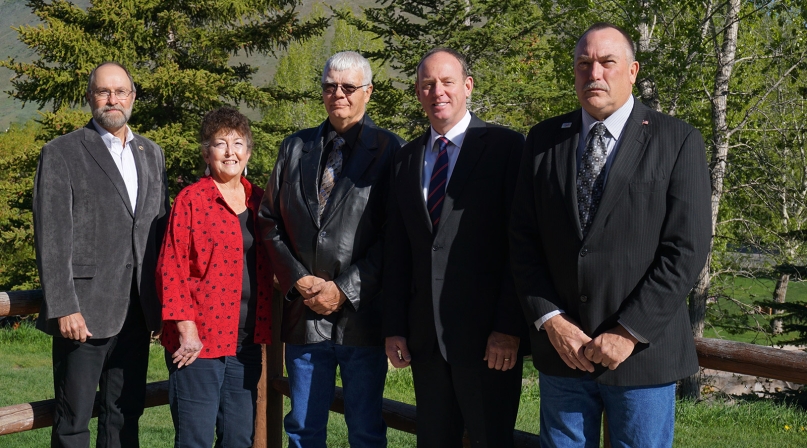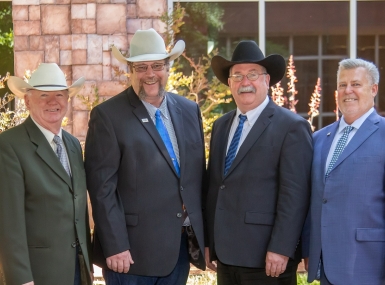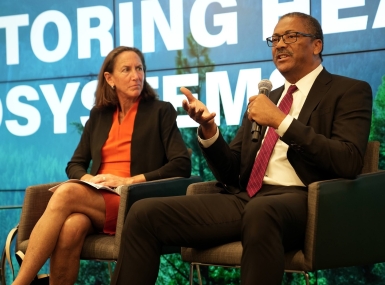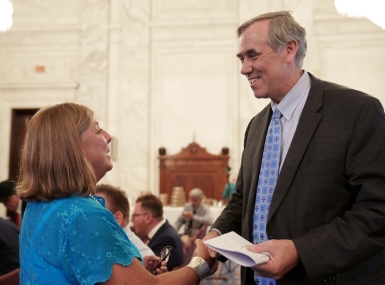Western Interstate Region members expand focus beyond public lands issues

The 2016–2017 WIR Executive Team members, following their installation at the 2016 WIR Conference May 27 in Teton County (Jackson), Wyo. From left: Kevin Cann, a Mariposa County, Calif. supervisor who will serve as WIR second vice president after Jan. 3. 2017; Second Vice President Tommie Cline Martin, a Gila County, Ariz. supervisor who will serve as second vice president; First Vice President Joel Bausman, a Sublette County, Wyo. commissioner; President Doug Breidenthal, a Jackson County, Ore. commissioner and Past President Gordon Cruickshank, a Valley County, Idaho commissioner. Photo by Charlie BanWIR Board elects two concurrent slates of officers at annual conference via @NACoTweets
Though public lands will always be at the core of NACo’s Western Interstate Region, WIR President Doug Breidenthal said the group has come to represent much more.
“WIR has shifted gears, we’re not just public lands,” he said at the WIR Conference May 24–27 in Teton County (Jackson), Wyo. “We’ve worked with transportation, we’ve worked with health care, we worked on economics that are special to our region.”
That said, he added, all of those result from the management, and mismanagement, of public lands in their counties.
Wyoming Gov. Matt Mead (R), Bureau of Land Management Director Neil Kornze, Grand Teton National Park Superintendent David Vela, Deputy Secretary of the Interior Michael Connor, Colorado Transportation Secretary Shailen Bhatt and pollster Scott Tranter spoke about Western interests at the conference’s general sessions.
“I think the Western region is on the horizon, that the sun is just starting to come up on Western issues,” Breidenthal said. “I’m seeing legislation move in Congress right now on public lands, things we’ve been working on for decades. We can make the case that the rising healthcare costs in our counties can be directly tied to some of those fires and disasters we deal with on public lands.”
Breidenthal, who lost in the Jackson County, Ore. Republican primary race for county commissioner May 17, will serve as WIR president until Jan. 3, 2017. First Vice President Joel Bousman, a Sublette County, Wyo. commissioner, will complete the remainder of Breidenthal’s term and take the leadership position in for a full term through May 2018.
Tommie Cline Martin, a Glia County, Ariz. supervisor and currently WIR second vice president, will move into the president’s slot in 2018. Kevin Cann, a Mariposa County, Calif. supervisor, will become WIR second vice president Jan. 3.
WIR bylaws did not prescribe a succession plan in event of an executive vacancy, according to parliamentarian Dan Chadwick, executive director of the Idaho Association of Counties, so the WIR membership elected two slates of candidates for the 2016–2017 term.
Chelan County, Wash. Commissioner Ron Walter, who is not running for reelection, and Phillips County, Mont. Commissioner Lesley Robinson, a candidate for Montana’s lieutenant governor’s office, were the Dale Sowards Award winners. The award recognizes WIR members who demonstrate outstanding service to public lands counties. Both served as WIR presidents.
While in Teton County, Agriculture and Rural Affairs Committee members toured Vertical Harvest, a greenhouse due to open the following day, built on a 30 foot by 150 foot plot. The greenhouse uses a four-story glass wall on the southern side that can balance natural light with artificial light, cutting energy costs. The crops, fed by a hydroponic solution, are moved throughout the building by a carousel.
“They’re the most pampered plants on the planet,” said CEO Nona Yehia. “They live in perfect conditions.”
Those conditions will create a yield of 100,000 pounds of produce in a year; what would usually take 5 acres can be accomplished in half of an acre. And the greenhouse can be used all year, much longer than northwestern Wyoming’s three-month growing season.
“I think people were expecting more of a traditional greenhouse structure that would add a few weeks to the growing season,” Yehia said.
The greenhouse grows tomatoes, several varieties lettuce, microgreens and basil, which is all sold to local businesses that were otherwise getting their produce outside of the Teton County area.
“We didn’t want to displace local farmers, and if we took this produce to a farmer’s market the demand would be too much,” Yehia said.
Vertical Harvest is a public-private partnership with the town of Jackson, which owns the building, but the business model is predicated on low profits. Fifteen of the 20 employees have some type of developmental disability, one of the primary tenets of the business.



